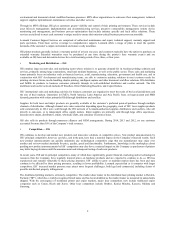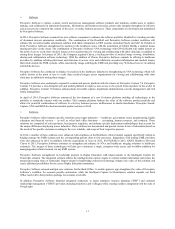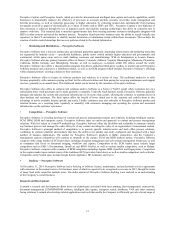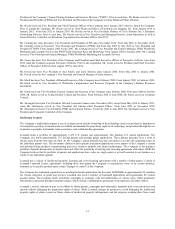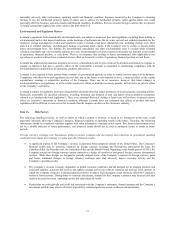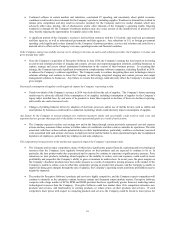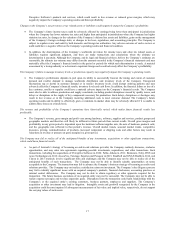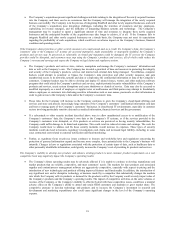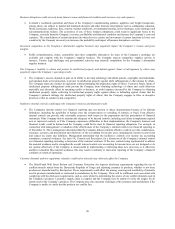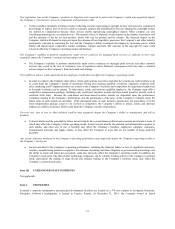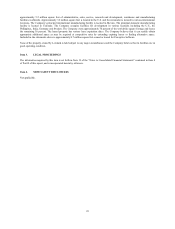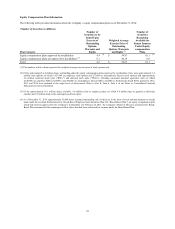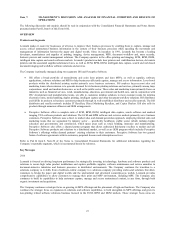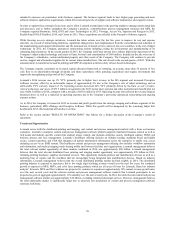Lexmark 2014 Annual Report Download - page 22
Download and view the complete annual report
Please find page 22 of the 2014 Lexmark annual report below. You can navigate through the pages in the report by either clicking on the pages listed below, or by using the keyword search tool below to find specific information within the annual report. The Company’s acquisitions present significant challenges and risks relating to the integration of the newly acquired business
into the Company, and there can be no assurances that the Company will manage the integration of the newly acquired
business successfully. The Company is in the process of integrating ReadSoft and other newly acquired businesses, and each
of the Company’s acquisitions pose integration challenges, including the retention of customers and key employees,
capitalizing on revenue synergies, and the difficulty of integrating business systems and technology. The Company’s
management may be required to spend a significant amount of time and resources to integrate these newly acquired
businesses and the anticipated benefits of the acquisition may take longer to achieve, if at all. If the Company fails to
integrate ReadSoft and other newly acquired businesses on a timely basis, the Company may not meet its expectations
regarding the profitability of such acquisitions, which could have an adverse impact on the Company’s business, financial
condition and operating results.
If the Company’s data protection or other security measures are compromised and, as a result, the Company’s data, the Company’s
customers’ data or the Company’s IT systems are accessed improperly, made unavailable, or improperly modified, the Company’s
products and services may be perceived as vulnerable, its brand and reputation could be damaged, the IT services the Company
provides could be disrupted, and customers may stop using the Company’s products and services, all of which could reduce the
Company’s revenue and earnings and expose the Company to legal claims and regulatory actions.
The Company’s products and services store, retrieve, manipulate and manage the Company’s customers’ information and
data as well as the Company’s own. The Company has invested a great deal of time and resources in protecting the integrity
and security of the Company’s products, services and internal and external data being managed. Nevertheless, computer
hackers could attempt to penetrate or bypass the Company’s data protection and other security measures and gain
unauthorized access to its networks, systems and data or compromise the confidential information or data of the Company’s
customers. Computer hackers may be able to develop and deploy IT related viruses, worms, and other malicious software
programs that could attack the Company’s products and services, exploit potential security vulnerabilities of the Company’s
products and services, create system disruptions and cause shutdowns or denials of service. Data may also be accessed or
modified improperly as a result of employee or supplier error or malfeasance and third parties may attempt to fraudulently
induce employees or customers into disclosing sensitive information such as user names, passwords or other information in
order to gain access to the Company’s data and/or the Company’s customers’ data.
These risks for the Company will increase as the Company continues to grow the Company’s cloud-based offerings and
services and store and process increasingly large amounts of the Company’s customers’ confidential information and data
and host or manage parts of the Company’s customers’ businesses in cloud-based IT environments, especially in customer
sectors involving particularly sensitive data such as medical information, financial services and the government.
If a cyberattack or other security incident described above were to allow unauthorized access to or modification of the
Company’s customers’ data, the Company’s own data or the Company’s IT systems, or if the services provided to the
Company’s customers were disrupted, or if its products or services are perceived as having security vulnerabilities, the
Company could suffer damage to its brand and reputation. This could result in reduced revenue and earnings. The costs the
Company would incur to address and fix these security incidents would increase its expenses. These types of security
incidents could also lead to lawsuits, regulatory investigations and claims and increased legal liability, including in some
cases contractual costs related to customer notification and fraud monitoring.
Further, as regulatory focus on privacy issues continues to increase and worldwide laws and regulations concerning the
protection of personal information expand and become more complex, these potential risks to the Company’s business will
intensify. Changes in laws or regulations associated with the protection of certain types of data, such as healthcare data or
other personally identifiable information, could greatly increase the Company’s cost of providing its products and services.
The Company’s inability to develop new products and enhance existing products to meet customer product requirements on a cost
competitive basis may negatively impact the Company’s operating results.
The Company’s future operating results may be adversely affected if it is unable to continue to develop, manufacture and
market products that are reliable, competitive, and meet customers’ needs. The markets for laser products and associated
supplies and content/process management software are aggressively competitive, especially with respect to pricing and the
introduction of new technologies and products offering improved features and functionality. In addition, the introduction of
any significant new and/or disruptive technology or business model by a competitor that substantially changes the markets
into which the Company sells its products or demand for the products sold by the Company could severely impact sales of
the Company’s products and the Company’s operating results. The impact of competitive activities on the sales volumes or
revenue of the Company, or the Company’s inability to effectively deal with these competitive issues, could have a material
adverse effect on the Company’s ability to attract and retain OEM customers and maintain or grow market share. The
competitive pressure to develop technology and products and to increase the Company’s investment in research and
development and marketing expenditures also could cause significant changes in the level of the Company’s operating
expense.
18



